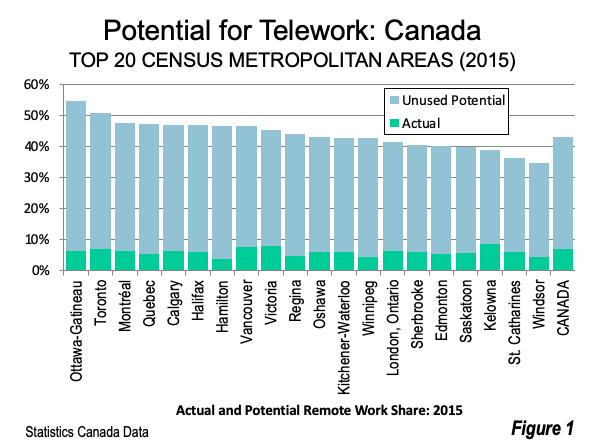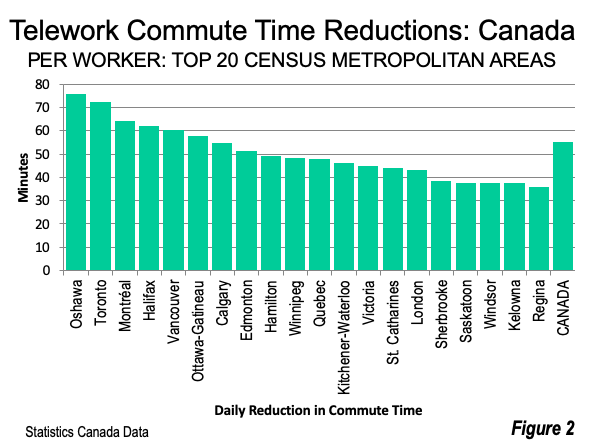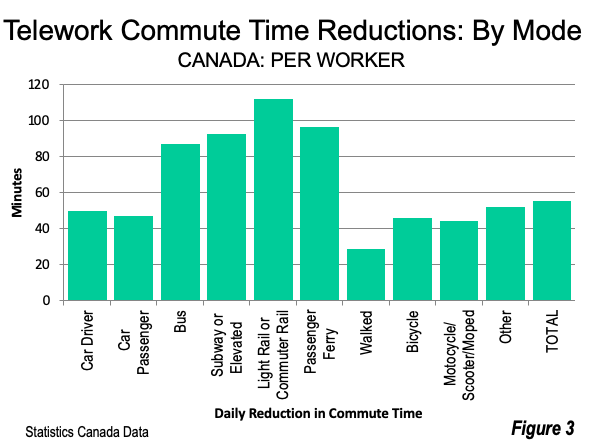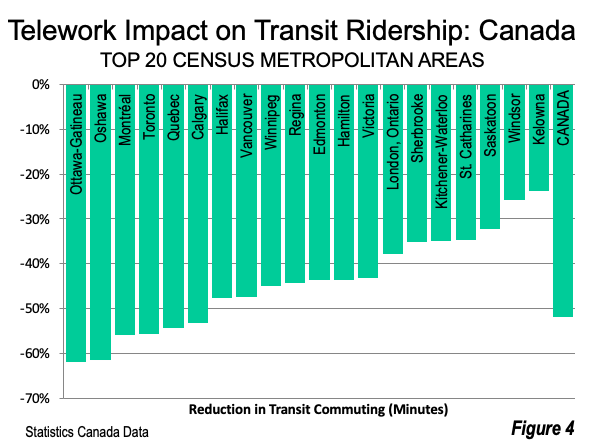
Canada’s greenhouse gas emissions could be reduced as much as 8.6 megatonnes (metric tons) if “all potential teleworkers would work from home most of the time,” instead of physically commuting (traveling to and from work). The analysis was performed by Statistics Canada, the national statistics and census office. As the April 22, 2021 Statistics Canada announcement indicates, “A transition to telework might lead to a non-negligible reduction in greenhouse gas emissions.” In other words, telework could result in substantial greenhouse gas emission reductions.
According to Statistics Canada, “This represents 6.0% of the direct GHG emissions from Canadian households in 2015 and 11.0% of their emissions attributable to transportation that year.”
The Potential for Telework
Before the pandemic, it is estimated that 43% of Canadian workers had jobs that could be performed at home (a worker holding “a job that could plausibly be done from home”). Before the pandemic seven percent worked at home, but there remains a 36 percentage point “unused” potential.
However, the potential is much greater in the larger census metropolitan areas (CMAs) because the office jobs concentrated there lend themselves best to telework. For example, the overall potential is 55% in the Ottawa-Gatineau CMA, where the national capital is located, compared to the pre-pandemic estimate of six percent. The overall potential is and 51% in Toronto, the nation’s financial center, compared to the pre-pandemic level of seven percent.
The overall potential for telework also exceeds 45% in the Montréal, Quebec, Calgary, Halifax, Hamilton, Vancouver and Victoria CMAs. Among the top 20 CMAs, only Saskatoon, Kelowna, St. Catharines-Niagara and Windsor have an overall potential less than 40%. The lowest potential is in the automobile manufacturing center of Windsor, across the river from Detroit. Manufacturing has comparatively little potential for telework (Figure 1).

Obviously, converting such a large share of commuters to telework would reduce traffic and traffic congestion substantially.
Commuter Tine Savings
But it’s not just emissions but also quality of life that improves. Statistics Canada, which collects journey to work in its national censuses every five years, estimates the average time daily (both ways) that new teleworkers would save by working at home rather than physically commuting to work at 55.3 minutes.
The largest reductions would be in the Oshawa CMA, located just outside the Toronto CMA and the Toronto CMA, at 75.7 minutes and 72.3 minutes daily. These workers would spend more than six hours less weekly in traffic commuting to work. Workers in Montréal, Halifax and Vancouver would spend at least an hour in their daily commutes by teleworking. Workers in Calgary, Edmonton and Hamilton (like Oshawa, adjacent to the Toronto CMA) would gain at least 50 minutes daily by teleworking.
In five CMAs, the gain would be less than 40 minutes daily, including Sherbrooke, Saskatoon, Windsor, Kelowna and Regina, which would have the smallest gain at 35.3 minutes (Figure 2).

Former users of light rail and commuter rail would save the most time by teleworking rather than traveling to work, at 111.8 minutes daily --- nearly two hours. The smallest reduction in travel time would be among those who walk, at 28.5 minutes. Commuters using bicycles, motorcycles, scooters and mopeds would save about 45 minutes daily. Bus riders would save an average of 87 minutes daily, while subway and elevated riders would save 93 minutes daily. Light rail and commuter rail passengers would save nearly two hours (Figure 3). These time savings would provide opportunities for greater leisure and other activities more valued than traveling from here to there.

Less Transit Commuting
One result of eliminating the work trip and its attendant greenhouse gas emissions would be to reduce transit ridership, especially to the largest central business districts (downtowns). Nationally, Statistics Canada estimates that full conversion to telework, where feasible would reduce transit commuting by 51.8%.
Transit commuting would drop the most in Ottawa-Gatineau, at 61.8%. A drop of 61.3% was estimated for the Oshawa CMA. In the Toronto and Montréal CMAs, with the two largest central business districts in the nation, the reduction would be approximately 55%, while greater than 50% reductions would be experienced in the Quebec and Calgary CMAs. Vancouver, Halifax, and Winnipeg would have transit commuting reductions of more than 45%.
These stronger potential losses reflect the reality in Canada --- that transit is about downtown (also called the central business district). In larger metropolitan areas, especially those that developed strong CBDs before World War II, transit carries a much larger share of commuting to downtown work locations. This can represent 50% or more of total transit commuting in the metropolitan area). The office jobs that are more concentrated in the CBDs, with their higher transit commuting share, can be more readily shifted to remote work. This contributes to the higher transit commuting loss predicted.
The smallest transit commuting reductions would be in Windsor, at 25.8% and Kelowna, at 23.8%. This is likely attributable to their smaller than average share of jobs that can be performed remotely (Figure 4).

The Potential for Reducing GHG Emissions and Related Benefits
As would be expected from such an assessment, Stats Canada suggests a number of caveats, but concludes:
“Nevertheless, the reductions in GHG emissions documented in this study provide a first Canadian estimate of the direct potential environmental gains associated with a transition to full telework capacity.
“Because there are several inherent limitations to the calculations of these figures, these findings are best interpreted as providing a useful starting point for quantifying the impacts of transitioning to a remote economy, rather than providing final and uncertainty-free estimates of these impacts.”
Nationally, it is estimated that that travel by automobile to and from work would be reduced by 35 million kilometers annually (22 million miles). This would reduce annual greenhouse gas emissions by from 7.3 to 9.9 megatonnes, with a midpoint of 8.6 megatonnes, which Statistics Canada uses as its principal estimate.
In this effort, Statistics Canada has provided ground-breaking analysis that shows the environmental potential of telework for the whole nation. But there are additional advantages. Greater telework seems likely to improve worker productivity. Workers pay less in fuel and maintenance costs for vehicles. They have more time to do things that they value more than unnecessarily traveling between a residence and a separate work location.
The inevitable reduction in traffic volumes and traffic congestion of increased telework seems likely to lead to improved economic performance across the nation. It’s a great opportunity if Canada, as well as other countries, seize upon it.
A Statistics Canada infographic summarizes the results of the analysis.
Wendell Cox is principal of Demographia, an international public policy firm located in the St. Louis metropolitan area. He is a founding senior fellow at the Urban Reform Institute, Houston, a Senior Fellow with the Frontier Centre for Public Policy in Winnipeg and a member of the Advisory Board of the Center for Demographics and Policy at Chapman University in Orange, California. He has served as a visiting professor at the Conservatoire National des Arts et Metiers in Paris. His principal interests are economics, poverty alleviation, demographics, urban policy and transport. He is co-author of the annual Demographia International Housing Affordability Survey and author of Demographia World Urban Areas.
Mayor Tom Bradley appointed him to three terms on the Los Angeles County Transportation Commission (1977-1985) and Speaker of the House Newt Gingrich appointed him to the Amtrak Reform Council, to complete the unexpired term of New Jersey Governor Christine Todd Whitman (1999-2002). He is author of War on the Dream: How Anti-Sprawl Policy Threatens the Quality of Life and Toward More Prosperous Cities: A Framing Essay on Urban Areas, Transport, Planning and the Dimensions of Sustainability.
Photograph: Centre Block, Parliament Buildings, Ottawa (by author).












